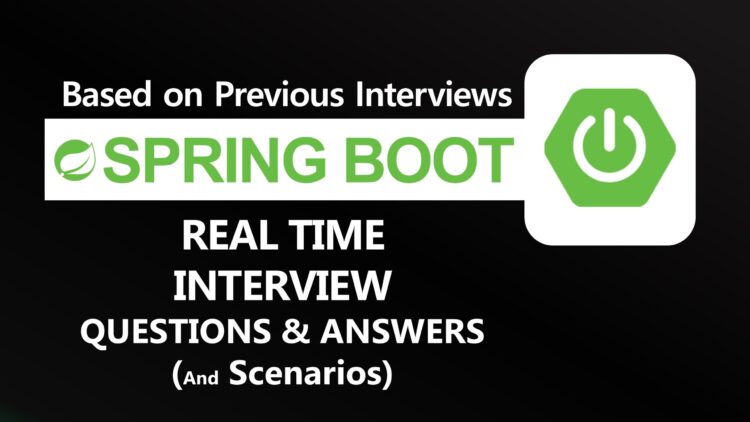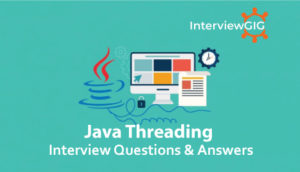Spring Boot Interview Questions and Answers with Scenarios for freshers & Experienced Candidates.
“Are you preparing for a Spring Boot interview? We’ve put together a comprehensive list of the most frequently asked questions, tailored for both freshers and experienced candidates. Drawing from real interview experiences, this guide covers everything you need to know to excel, from foundational concepts to scenario-based questions that simulate real-world challenges. Each question is paired with a sample answer to help you understand how to approach complex problems with confidence. Dive in, and get ready to tackle your Spring Boot interview like a pro!”
Spring Boot is a powerful framework designed to simplify the development of Java-based applications, especially those built on the Spring Framework. It streamlines the setup process by eliminating the need for extensive XML configurations, making it easier and faster to build stand-alone, production-ready applications. With features like embedded servers, auto-configuration, and a suite of production-ready tools, Spring Boot enables developers to focus on coding rather than configuration. This makes it a popular choice for creating microservices and modern, scalable applications.
Question: What is Spring Boot and how does it simplify Java development?
Answer: Spring Boot is a framework built on top of the Spring Framework, designed to simplify Java application development by providing pre-configured setups and reducing the need for boilerplate code. It enables developers to quickly create standalone, production-ready applications with embedded servers, minimizing configuration efforts.
Question: What is the difference between Spring Framework and Spring Boot?
Answer: Spring Framework provides a comprehensive programming and configuration model for Java-based enterprise applications, but requires extensive configuration. Spring Boot, on the other hand, builds on the Spring Framework but offers auto-configuration, embedded servers, and sensible defaults to eliminate much of the manual setup, making it easier to get started quickly.
Question: How does Spring Boot simplify application development?
Answer:
Convention over Configuration: Spring Boot adopts a convention-over-configuration approach, meaning it automatically configures common settings based on your project structure and dependencies. This reduces the amount of boilerplate code and configuration required.
Embedded Servers: Spring Boot includes embedded servers like Tomcat, Jetty, or Netty, allowing you to package your application as a standalone executable. This eliminates the need for external application servers.
Starter Dependencies: Spring Boot provides starter dependencies, which bundle together all the necessary dependencies for specific use cases (e.g., web, data, security). This simplifies dependency management and ensures compatibility.
Cli: Spring Boot CLI provides a command-line interface for creating, running, and testing Spring Boot applications. This makes it easy to get started with minimal setup.
Actuator: Spring Boot Actuator provides endpoints for monitoring and managing your application, such as health checks, metrics, and environment information.
Question: How does Spring Boot automatically configure your application?
Answer: Spring Boot uses a feature called Auto-Configuration, which intelligently guesses the necessary configurations based on the dependencies present in the classpath. It applies default configurations unless overridden by the developer, allowing for quick application setup while still offering flexibility for customization. For example, if you add the Spring Web dependency, Spring Boot will automatically configure a web server (like Tomcat) and necessary components like DispatcherServlet.
Question: What are Spring Boot starters, and why are they useful?
Answer: Spring Boot starters are pre-packaged dependencies that bundle together all the necessary dependencies for specific use cases. For example, the spring-boot-starter-web starter includes dependencies for creating web applications, while the spring-boot-starter-data-jpa starter includes dependencies for using JPA with Spring Data. Starters simplify dependency management and ensure compatibility between components.
Question: What are conditional annotations in Spring Boot?
Answer: Conditional annotations in Spring Boot provide a mechanism to conditionally include or exclude components (beans, configurations, etc.) based on specific conditions. These conditions can be related to the environment, classpath, or other factors.
Commonly used conditional annotations:
@ConditionalOnClass: Includes a component if a specific class is present on the classpath.
@ConditionalOnMissingClass: Includes a component if a specific class is not present on the classpath.
@ConditionalOnProperty: Includes a component based on the value of a specific property in the application.properties file.
@ConditionalOnBean: Includes a component if a specific bean is present in the application context.
@ConditionalOnResource: Includes a component if a specific resource is present on the classpath.
Question: What is the role of @SpringBootApplication in Spring Boot applications?
Answer:
@SpringBootApplication is a composite annotation that combines several other annotations to create a standalone Spring Boot application. It includes:
@Configuration: Marks the class as a configuration class, defining beans for the application.
@EnableAutoConfiguration: Enables Spring Boot’s auto-configuration mechanism, automatically configuring components based on the presence of dependencies on the classpath.
@ComponentScan: Scans for components (beans, configurations, etc.) within a specified package or set of packages.
Question: What annotations did you use in your previous projects, and why did you choose those specific annotations?
Answer: In my previous projects, I used a variety of Spring Boot annotations, including:
@RestController: To expose REST APIs.
@RequestMapping and @GetMapping, @PostMapping, etc.: For handling HTTP requests.
@Autowired: For dependency injection of services and repositories.
@Transactional: To manage transactions at the service level.
@Entity and @Table: For mapping Java classes to database tables in JPA/Hibernate. I chose these annotations because they streamline the development process, reduce boilerplate code, and enable declarative programming practices that simplify code maintenance.
Question: Which annotation can be used to handle HTTP requests in Spring Boot, and why would you choose it?
Answer: The @RequestMapping or its specialized forms like @GetMapping, @PostMapping, @PutMapping, and @DeleteMapping are used to handle HTTP requests in Spring Boot.
I would choose these annotations because they provide clarity and simplicity in defining the HTTP method (GET, POST, PUT, DELETE) and the URL path associated with each method. For instance, @GetMapping("/users") is more readable and easier to maintain than the generic @RequestMapping(method = RequestMethod.GET, value = "/users").
Question: Explain what Spring Boot’s @Configuration and @Bean annotations are used for?
Answer:
@Configuration: Marks a class as a source of bean definitions. This tells Spring that the class contains methods annotated with @Bean that will define beans in the application context.
@Bean: Indicates that the method will return an object that should be registered as a bean in the Spring application context. This is typically used for manually creating and configuring beans when auto-wiring or component scanning is not sufficient.
Question: What is the difference between @Controller and @RestController in Spring Boot, and when would you use each?
Answer:
@Controller: This annotation is used to define a Spring MVC controller that handles web requests and returns a view (usually a JSP or Thymeleaf template). It’s typically used in applications that follow the traditional Model-View-Controller (MVC) pattern, where the controller returns the view name, and the view resolver renders the HTML page.
@RestController: This is a combination of @Controller and @ResponseBody. It is used in RESTful web services where the response is not a view but rather JSON or XML data. Every method in a @RestController will return the response directly as the body of the HTTP response.
When to use:
Use @Controller when you are developing a web application with a user interface that returns HTML views.
Use @RestController when developing RESTful APIs where the response is primarily data (JSON or XML) instead of a rendered view.
Question: How do you handle multiple beans of the same type in Spring Boot?
Answer: When you have multiple beans of the same type, Spring Boot can handle this using several strategies:
@Qualifier: You can use the @Qualifier annotation to specify which bean should be injected in the case of multiple beans. Example:
@Autowired
@Qualifier("beanName")
private MyService myService;
@Primary: You can annotate one of the beans with @Primary, making it the default bean to inject when no specific bean is named.
@Primary
@Bean
public MyService primaryService() {
return new MyServiceImpl();
}
Using Lists or Maps: You can also inject a collection of beans if you need to work with multiple beans of the same type.
@Autowired
private List<MyService> services;
Question: Explain the purpose of the @RequestMapping and @GetMapping annotations.
Answer:
@RequestMapping: A more general annotation for mapping HTTP requests to specific methods. It supports various HTTP methods (GET, POST, PUT, DELETE, etc.) and can be used with path variables and query parameters.
@GetMapping: A specialized annotation for mapping GET requests. It’s a shortcut for @RequestMapping(method = RequestMethod.GET).
Question: What is the role of @Autowired in Spring Boot?
Answer: @Autowired is an annotation used in Spring Boot to automatically wire dependencies into a bean. When you annotate a field, setter method, or constructor parameter with @Autowired, Spring will attempt to find a suitable bean of that type in the application context and inject it into the current bean.
Question: How do you configure a Spring Boot application using application properties?
Answer: Spring Boot allows you to configure your application via the application.properties or application.yml file. This file is located in the src/main/resources directory and can be used to define configurations such as:
Server port: server.port=8081
Datasource configuration:
spring.datasource.url=jdbc:mysql://localhost:3306/mydb
spring.datasource.username=root
spring.datasource.password=secret
Question: You can also bind properties to fields in your classes using @Value or @ConfigurationProperties annotations for custom properties.
Example:
Answer: @Value("${custom.property}")
private String customProperty;
Question: What is Spring Boot DevTools and how does it help in development?
Spring Boot DevTools is a development tool that enhances the developer experience by providing features like:
Automatic Restart: It automatically restarts the application whenever files are changed in the classpath, improving the development workflow by reducing the need to manually restart the application.
LiveReload Integration: It allows the browser to refresh automatically when the code or templates are modified.
Development-Time Properties: It can enable additional properties useful in development, like disabling template caching.
Question: How do you enable caching in a Spring Boot application?
Answer: To enable caching in a Spring Boot application, follow these steps:
Add the required cache dependency in your pom.xml (for example, using EhCache, Redis, or Hazelcast).
Enable caching by adding the @EnableCaching annotation in your Spring Boot application class.
@SpringBootApplication
@EnableCaching
public class Application {
}
Use caching annotations such as @Cacheable, @CacheEvict, and @CachePut in your service methods to control the caching behavior.
@Cacheable("users")
public User getUserById(Long id)
{
return userRepository.findById(id).orElse(null);
}
In this example, the result of the getUserById method will be cached in the “users" cache.
Question: If you had to configure your own database reducer or override the default database settings, how would you configure your database in Spring Boot?
Answer: To configure or override the default database settings in Spring Boot, follow these steps:
Define the DataSource: In the application.properties or application.yml file, configure your custom database connection properties. For example, for an H2 or MySQL database
Override Default Settings with Custom Beans: If you need custom configuration, you can override the DataSource, EntityManagerFactory, or TransactionManager beans in a @Configuration class.
Question: How does Spring Boot handle embedded servers like Tomcat and Jetty?
Answer: Spring Boot includes embedded servers (like Tomcat, Jetty, and Undertow) out of the box. This means that you don’t need to install or configure an external web server; Spring Boot packages the server inside your application’s JAR or WAR file.
- By default, Spring Boot uses Tomcat as the embedded server.
- To change the embedded server (e.g., to Jetty), you can exclude the Tomcat dependency and include the Jetty dependency in your pom.xml or build.gradle.
- Spring Boot automatically configures the server and binds it to the application. You can customize the server settings (like port, context path) through the application.properties file. Example:
server.port=8081
server.servlet.context-path=/myapp
If you need advanced configuration (e.g., SSL or connection pool settings), you can customize the embedded server programmatically using TomcatServletWebServerFactory or similar classes for Jetty and Undertow.
Question: How would you configure multiple databases in Spring Boot, particularly using Oracle?
Answer: To configure multiple databases in Spring Boot, you can use different data sources and name them. Then, you can inject the appropriate data source into your repositories or services using the @Qualifier annotation.
Question: What is the application.properties or application.yml file used for in Spring Boot?
Answer: These files are used to configure various aspects of a Spring Boot application, such as database connections, server port, logging levels, and custom application settings. You can define environment-specific settings and externalize configuration properties for flexibility and better maintainability.
Question: Can you explain auto-configuration in Spring Boot and how it relates to dependency injection?
Answer: Auto-configuration in Spring Boot automatically configures components, services, and settings based on the application’s dependencies and classpath, reducing manual configuration. It leverages Spring’s dependency injection to create and wire beans automatically, making development faster and reducing boilerplate code.
Question: How would you optimize a Spring Boot application for high performance and scalability?
Answer: To optimize for performance and scalability:
- Use caching (
@EnableCaching). - Optimize database queries (e.g., using indexes).
- Use asynchronous processing (
@Async). - Optimize resource usage (memory, CPU) and use connection pools.
- Scale horizontally using cloud platforms like AWS or Azure.
- Implement load balancing and configure autoscaling for distributed environments.
Question: How can you override Spring Boot’s default configuration?
Answer: You can override Spring Boot’s default configuration by:
- Defining custom properties in application.properties or application.yml.
- Providing custom beans in a
@Configurationclass. - Using
@Primary to override specific beans. - Excluding specific auto-configurations using
@SpringBootApplication(exclude = ...).
Question: How do you secure a Spring Boot application using Spring Security?
Answer: To secure a Spring Boot application:
- Add the Spring Security dependency to your project.
- Use the @EnableWebSecurity annotation to configure security settings.
- Define authentication and authorization rules (e.g., form-based login, OAuth2, JWT).
- Implement role-based access control (RBAC) using methods like @PreAuthorize.
- Configure HTTP security to protect endpoints and enforce HTTPS.
Question: How would you create an endpoint in a Spring Boot application that allows users to upload files?
Answer: Use the @PostMapping annotation with MultipartFile to handle file uploads. Example:
@PostMapping("/upload")
public String uploadFile(@RequestParam("file") MultipartFile file) {
// Handle file processing logic here
return "File uploaded successfully";
}
Configure MultipartResolver in application.properties for file handling settings (e.g., file size limits).
Question: How do you manage database migrations in a Spring Boot application using Liquibase or Flyway?
Answer:
- Add the Liquibase or Flyway dependency to your project.
- Define migration scripts (SQL or XML/YAML for Liquibase) in the db/migration folder for Flyway or Liquibase’s default folder.
- Spring Boot auto-runs the migrations on startup, keeping the database schema synchronized with the application.
Question: Explain how you can deploy a Spring Boot application on cloud platforms like AWS or Azure.
Answer:
AWS:
- Create an EC2 instance or use a managed service like Elastic Beanstalk or ECS.
- Deploy your Spring Boot JAR or WAR file.
- Configure necessary services like S3 for storage or RDS for databases.
Azure:
- Create a virtual machine or use a managed service like Azure App Service.
- Deploy your Spring Boot JAR or WAR file.
- Configure necessary services like Azure Blob Storage or Azure SQL Database.
Question: How do you handle distributed transactions in microservices with Spring Boot?
Answer:
- Use the Saga Pattern for distributed transaction management, breaking the transaction into multiple steps, each handled by a service.
- Implement message-driven transactions using tools like Kafka or RabbitMQ to ensure eventual consistency between microservices.
- Use
@Transactionalannotations carefully to manage local transactions within individual microservices.
Question: Describe how Spring Boot supports event-driven architecture using RabbitMQ/Kafka.
Answer: Spring Boot integrates with RabbitMQ and Kafka through the Spring Cloud Stream framework.
- Use
@EnableBindingand@StreamListenerfor handling messaging with RabbitMQ or Kafka. - You can send and consume events between microservices using
@SendTo and @KafkaListener or @RabbitListenerto build an event-driven architecture.
Question: Explain how to implement JWT-based authentication in Spring Boot?
Answer: Implement JWT by creating an authentication controller that issues a JWT token after validating user credentials.
Use spring-boot-starter-security to secure the application, and configure a filter to intercept requests, validate JWT tokens, and grant access based on user roles.
Store JWT in the Authorization header and verify it using a JWT utility class.
Question: How do you configure and consume external RESTful APIs in Spring Boot?
Answer: Add dependency: Include spring-boot-starter-web in your pom.xml or build.gradle.
Create RestTemplate: Use RestTemplate to make HTTP requests.
Configure RestTemplate: Set headers, timeouts, or interceptors.
Make requests: Call methods like get(), post(), etc., to consume the API.
Question: How do you resolve the White Label Error Page in Spring Boot?
Answer:
To resolve the White Label Error Page, either:
- Disable it by setting server.error.whitelabel.enabled=false in application.properties.
- Create a custom error page by defining a controller or error.html in the src/main/resources/templates folder.
Question: Explain the use of the @Scheduled annotation for task scheduling in Spring Boot.
Answer:
Define a method: Annotate a method with @Scheduled to schedule it.
Set cron expression: Specify the scheduling pattern using a cron expression.
Run task: Spring Boot will execute the method at the specified intervals.
Question: What are some strategies for handling concurrency in Spring Boot applications?
Answer:
Use synchronized blocks or locks to manage shared resources.
Employ optimistic or pessimistic locking for database transactions (via JPA’s @Version or @Lock).
Use ExecutorService or @Async to handle asynchronous tasks and parallel processing.
Leverage concurrent data structures like ConcurrentHashMap for thread-safe operations.
Question: Describe a real-world scenario where you used Spring Boot’s @Async for asynchronous processing?
Answer:
In a real-world scenario, I used @Async to handle email notifications after a user registered on the application. The email-sending process was made asynchronous to avoid blocking the main thread and ensure the registration process completed faster without waiting for email delivery.
@Async
public void sendEmail(String recipient)
{ // Email sending logic
}
Question: How do you manage configuration for different environments (dev, prod) in Spring Boot?
Answer:
Spring Boot uses profiles to manage environment-specific configurations. You can define properties for each profile in separate files such as application-dev.properties or application-prod.properties.
Activate a profile via the spring.profiles.active property, either in the application.properties file or as a command-line argument.
Example:
spring.profiles.active=dev
Question: Explain the concept of circuit breaker patterns and how Spring Boot integrates with Hystrix or Resilience4j.
Answer:
The circuit breaker pattern helps prevent cascading failures in distributed systems by opening (stopping) requests to a failing service after it exceeds failure thresholds.
Spring Boot integrates with Hystrix or Resilience4j to implement circuit breakers. With Resilience4j, you can annotate methods with @CircuitBreaker to protect external service calls.
@CircuitBreaker(name = "serviceName", fallbackMethod = "fallbackMethod")
public String externalCall() {
// External service logic
}
Scenario-Based Questions for Both Freshers & Experienced:
Question: You need to upload files in a Spring Boot application. How would you implement a file upload REST API?
Answer: Use MultipartFile in a @PostMapping to handle file uploads. Example:
@PostMapping("/upload")
public String uploadFile(@RequestParam("file") MultipartFile file) {
// Save file logic
return "File uploaded successfully";
}
Configure file upload limits in application.properties using spring.servlet.multipart.
Question: A user has registered on your platform. How would you send a welcome email using Spring Boot?
Answer: Use Spring Mail by configuring the mail server in application.properties.
Inject JavaMailSender to send the email in an @Async method
Question: Your Spring Boot application encounters performance issues under high load. How do you troubleshoot and resolve this?
Answer:
Steps to troubleshoot:
Profile the application using tools like VisualVM or JProfiler to find bottlenecks.
Analyze logs and metrics with tools like Micrometer and Prometheus.
Use caching (@EnableCaching) and optimize database queries.
Scale the application by increasing instances or implementing horizontal scaling with cloud services like AWS/Azure.
Question: Can we create non-web applications using Spring Boot? If yes, how?
Answer: Yes, Spring Boot can be used for non-web applications. To create a command-line or batch processing application, use the @SpringBootApplication annotation and implement the CommandLineRunner or ApplicationRunner interface.
Question: How do you handle multiple data sources in a Spring Boot application?
Answer:
Define multiple DataSource beans in a @Configuration class and mark one as @Primary.
Use @Qualifier to specify which data source to use in repositories or services.
Question: Explain how you would handle a 404 error in a Spring Boot application?
Answer:
Custom error controller: Implement ErrorController and return a custom error page for 404 errors.
Global exception handler: Use @ControllerAdvice to handle exceptions globally and return appropriate HTTP status codes.
Question: You need to implement pagination and sorting for a large dataset in your REST API. How do you approach this?
Answer:
Pagination:
Limit and offset: Use query parameters like limit and offset to control the number of items returned and the starting point.
Page number and size: Use page and size parameters to specify the page number and number of items per page.
Cursor-based pagination: Use a cursor value to mark the position in the result set.
Sorting:
Sort parameter: Allow users to specify a sort parameter with a comma-separated list of fields and their sorting order (ascending or descending).
Sorting implementation: Use Spring Data JPA’s Pageable interface to implement sorting.
Question: You need to deploy your Spring Boot application as a WAR file. How do you configure your application for this?
Answer: Change the packaging type to WAR in pom.xml:
<packaging>war</packaging>
Extend SpringBootServletInitializer in your main application class:
Package the application using mvn clean package and deploy the WAR file to a servlet container like Tomcat.
Question: How do you handle microservice failures in a Spring Boot-based microservices architecture?
Answer:
- Implement circuit breaker patterns using tools like Hystrix or Resilience4j to handle failures gracefully and prevent cascading issues.
- Use retry mechanisms and fallback methods to ensure services recover from transient failures.
- Employ service discovery and load balancing to redirect requests away from failing services.
Question: Describe how you would use Spring Boot’s Actuator for monitoring your application in production.
Answer: Enable Spring Boot Actuator by adding the dependency to your pom.xml and configure it in application.properties:
management.endpoints.web.exposure.include=health,metrics
Use the /actuator/health endpoint to check application health and /actuator/metrics to view various metrics such as JVM memory usage and HTTP request statistics. You can also integrate Actuator with monitoring tools like Prometheus and Grafana for more comprehensive insights.
Question: How would you implement a global exception handler for a REST API in Spring Boot?
Answer: Create a @ControllerAdvice class: Annotate a class with @ControllerAdvice to make it a global exception handler.
Define exception handling methods: Create methods annotated with @ExceptionHandler to handle specific exceptions. The method should take the exception as a parameter and return a ResponseEntity object.
Question: Explain how to use RabbitMQ or Kafka for messaging in a Spring Boot application.
Answer: Add dependencies: Include spring-boot-starter-amqp for RabbitMQ or spring-boot-starter-kafka for Kafka.
Configure broker: Set up the message broker (RabbitMQ or Kafka) and configure its connection details in your application.properties.
Produce messages: Use @KafkaTemplate or @RabbitTemplate to send messages to topics or queues.
Consume messages: Use @KafkaListener or @RabbitListener to consume messages from topics or queues.
Question: How do you integrate Spring Boot with external APIs, and what are some best practices for handling failures?
Answer: Use RestTemplate: Create a RestTemplate object to make HTTP requests to external APIs.
Handle exceptions: Use try-catch blocks or @ControllerAdvice to handle exceptions like HttpClientErrorException or HttpServerErrorException.
Implement retry logic: Use a retry mechanism (e.g., RetryTemplate) to automatically retry failed requests.
Circuit breaker pattern: Employ a circuit breaker pattern to prevent cascading failures.
Rate limiting: Implement rate limiting to avoid overloading external APIs.




